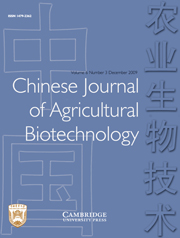No CrossRef data available.
Article contents
Biological characteristics of recombinant enhancin of Trichoplusia ni granulovirus expressed in Escherichia coli
Published online by Cambridge University Press: 20 March 2007
Abstract
A recombinant enhancin from Trichoplusia ni granulovirus, expressed in Escherichia coli and named P96, had been shown in a previous study to increase significantly the efficacy of bio-insecticides applied to insect pests. Here, several biological characteristics were clarified to provide further proof for the activities of P96. The inclusion bodies formed by P96 were quite stable when expressed in E. coli; however, they could be effectively dissolved in sodium carbonate (Na2CO3) solution or in the midgut digestive secretion of the fifth-instar larvae of the cotton bollworm, Helicoverpa armigera, in vitro. According to sodium dodecyl sulphate–polyacrylamide gel electrophoresis (SDS-PAGE), the peritrophic membrane of the cotton bollworm was clearly decomposed by P96. With the increase of P96 concentration, the mortality of the cotton bollworm caused by nuclear polyhedrosis virus increased up to its saturation concentration, 6.76×105 inclusion bodies/ml. The bioactivity of P96 was strongly inhibited by ethylenediaminetetraacetic acid (EDTA), which formed a complex compound with the metal ion (Zn2+) in the protein.
- Type
- Research Article
- Information
- Copyright
- China Agricultural University and Cambridge University Press 2006


